International Human Resource Management in Australian Banking
VerifiedAdded on 2023/01/04
|16
|3853
|90
Report
AI Summary
This report provides a comprehensive overview of International Human Resource Management (HRM) within the Australian banking sector. It begins with an executive summary highlighting the industry's significance and potential risks, followed by an introduction outlining the report's scope and purpose. The report then delves into the history and overview of the Australian banking system, its key features, and current challenges, including employment relations, organizational misconduct, and outsourcing arrangements. Key HRM issues such as organizational culture, lack of employee motivation, and leadership quality are thoroughly examined. The report also analyzes HR practices, including recruitment processes and reward systems. Finally, recommendations are made to improve performance, and the report concludes with a summary of findings and references.
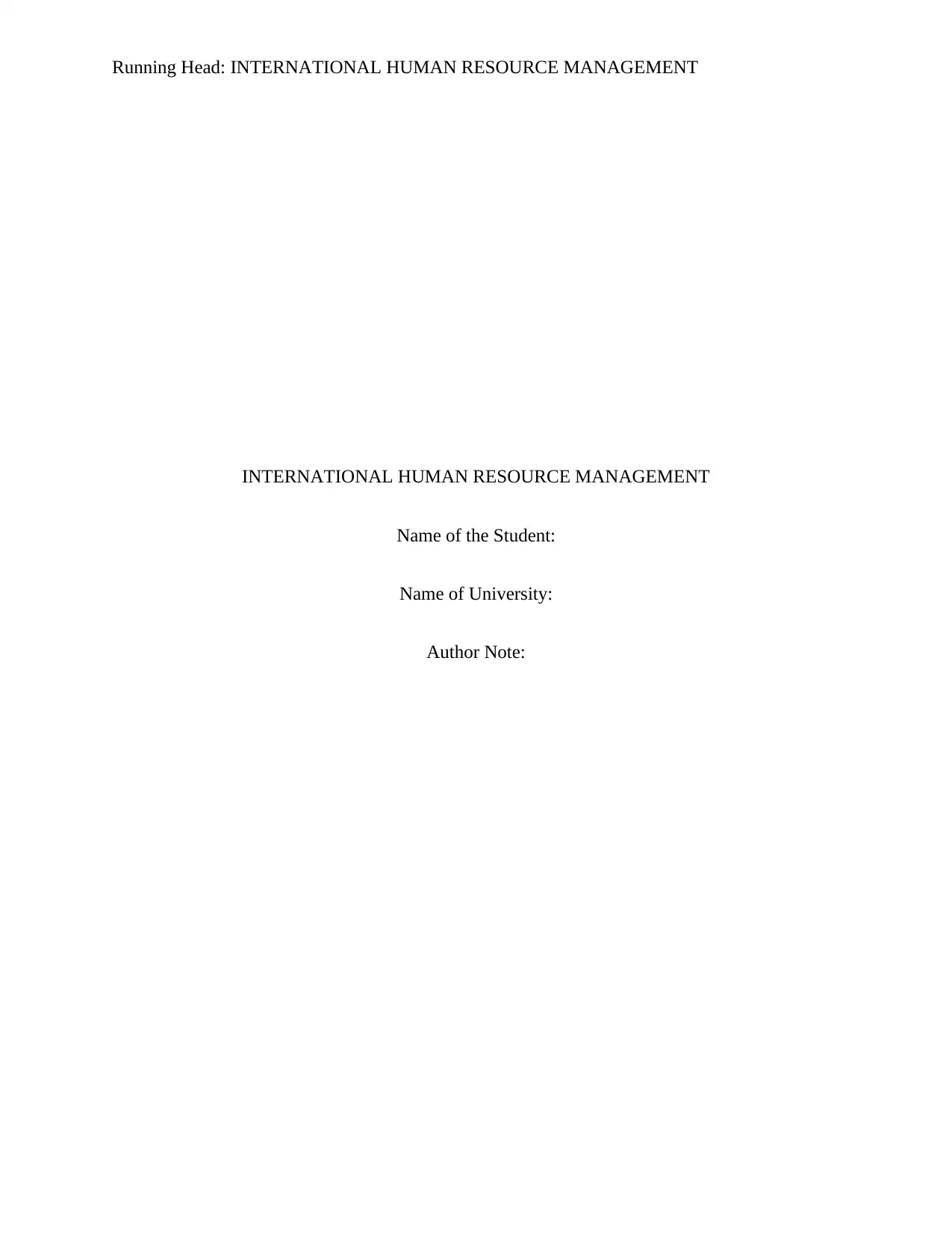
Running Head: INTERNATIONAL HUMAN RESOURCE MANAGEMENT
INTERNATIONAL HUMAN RESOURCE MANAGEMENT
Name of the Student:
Name of University:
Author Note:
INTERNATIONAL HUMAN RESOURCE MANAGEMENT
Name of the Student:
Name of University:
Author Note:
Paraphrase This Document
Need a fresh take? Get an instant paraphrase of this document with our AI Paraphraser
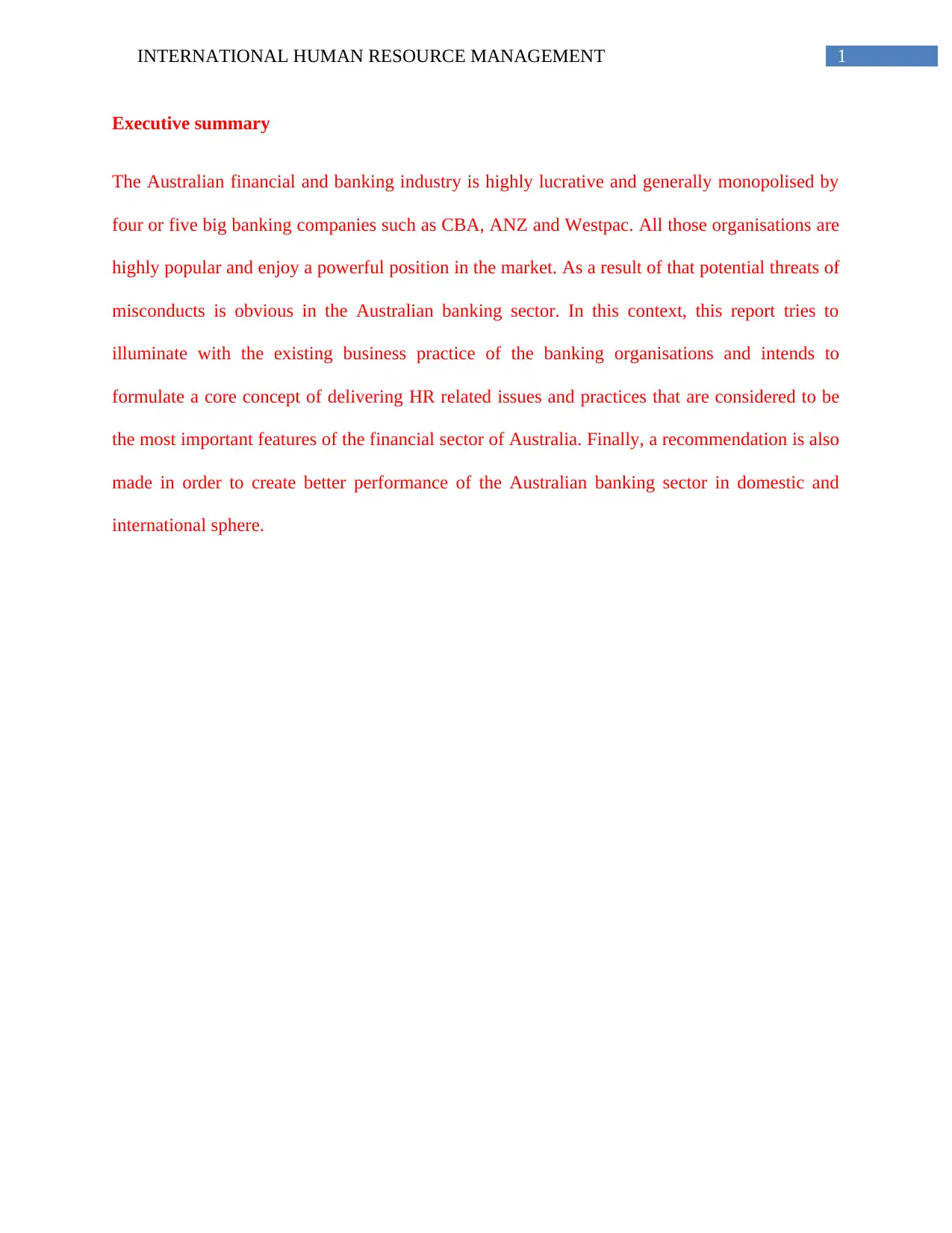
1INTERNATIONAL HUMAN RESOURCE MANAGEMENT
Executive summary
The Australian financial and banking industry is highly lucrative and generally monopolised by
four or five big banking companies such as CBA, ANZ and Westpac. All those organisations are
highly popular and enjoy a powerful position in the market. As a result of that potential threats of
misconducts is obvious in the Australian banking sector. In this context, this report tries to
illuminate with the existing business practice of the banking organisations and intends to
formulate a core concept of delivering HR related issues and practices that are considered to be
the most important features of the financial sector of Australia. Finally, a recommendation is also
made in order to create better performance of the Australian banking sector in domestic and
international sphere.
Executive summary
The Australian financial and banking industry is highly lucrative and generally monopolised by
four or five big banking companies such as CBA, ANZ and Westpac. All those organisations are
highly popular and enjoy a powerful position in the market. As a result of that potential threats of
misconducts is obvious in the Australian banking sector. In this context, this report tries to
illuminate with the existing business practice of the banking organisations and intends to
formulate a core concept of delivering HR related issues and practices that are considered to be
the most important features of the financial sector of Australia. Finally, a recommendation is also
made in order to create better performance of the Australian banking sector in domestic and
international sphere.
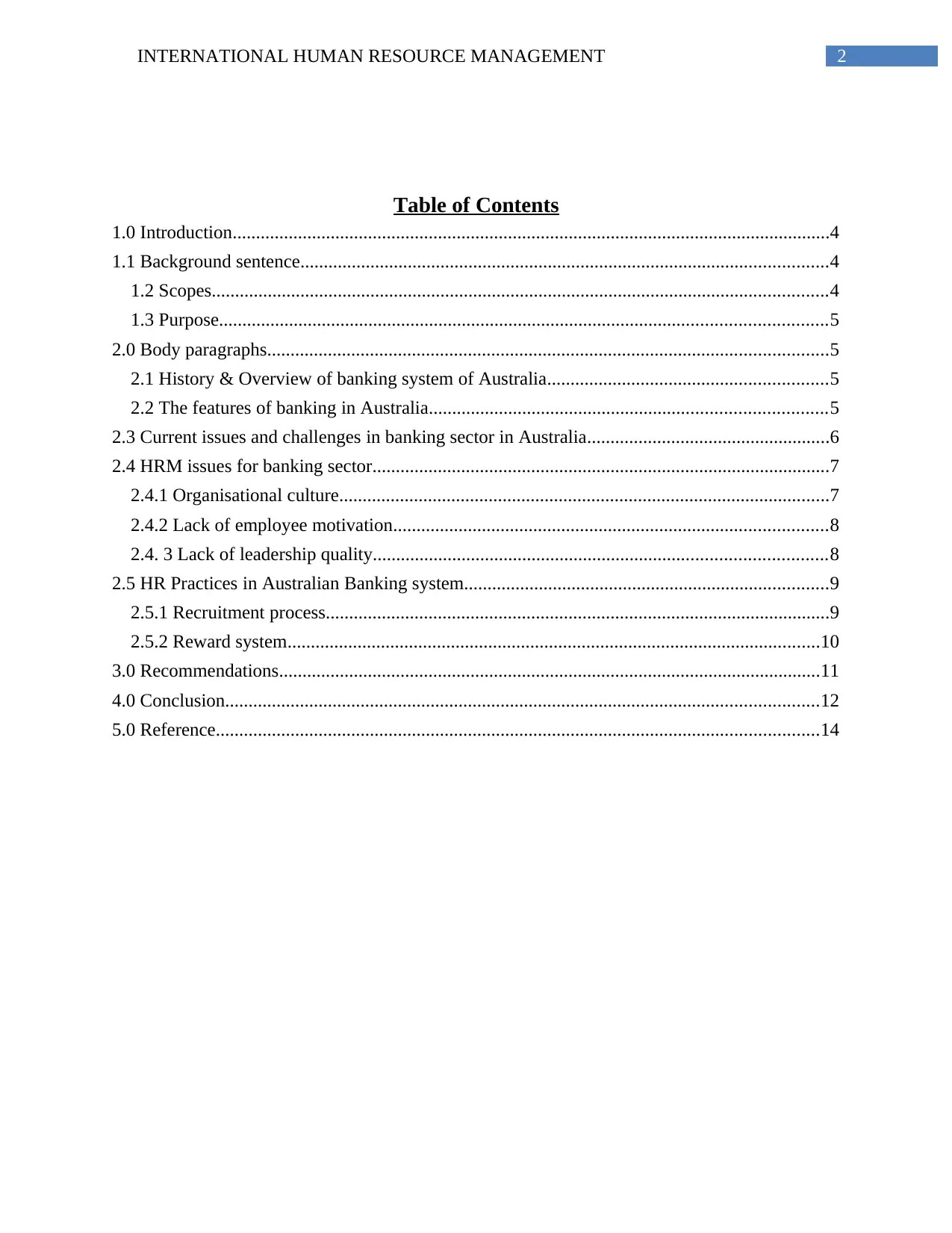
2INTERNATIONAL HUMAN RESOURCE MANAGEMENT
Table of Contents
1.0 Introduction................................................................................................................................4
1.1 Background sentence.................................................................................................................4
1.2 Scopes....................................................................................................................................4
1.3 Purpose..................................................................................................................................5
2.0 Body paragraphs........................................................................................................................5
2.1 History & Overview of banking system of Australia............................................................5
2.2 The features of banking in Australia.....................................................................................5
2.3 Current issues and challenges in banking sector in Australia....................................................6
2.4 HRM issues for banking sector..................................................................................................7
2.4.1 Organisational culture.........................................................................................................7
2.4.2 Lack of employee motivation.............................................................................................8
2.4. 3 Lack of leadership quality.................................................................................................8
2.5 HR Practices in Australian Banking system..............................................................................9
2.5.1 Recruitment process............................................................................................................9
2.5.2 Reward system..................................................................................................................10
3.0 Recommendations....................................................................................................................11
4.0 Conclusion...............................................................................................................................12
5.0 Reference.................................................................................................................................14
Table of Contents
1.0 Introduction................................................................................................................................4
1.1 Background sentence.................................................................................................................4
1.2 Scopes....................................................................................................................................4
1.3 Purpose..................................................................................................................................5
2.0 Body paragraphs........................................................................................................................5
2.1 History & Overview of banking system of Australia............................................................5
2.2 The features of banking in Australia.....................................................................................5
2.3 Current issues and challenges in banking sector in Australia....................................................6
2.4 HRM issues for banking sector..................................................................................................7
2.4.1 Organisational culture.........................................................................................................7
2.4.2 Lack of employee motivation.............................................................................................8
2.4. 3 Lack of leadership quality.................................................................................................8
2.5 HR Practices in Australian Banking system..............................................................................9
2.5.1 Recruitment process............................................................................................................9
2.5.2 Reward system..................................................................................................................10
3.0 Recommendations....................................................................................................................11
4.0 Conclusion...............................................................................................................................12
5.0 Reference.................................................................................................................................14
⊘ This is a preview!⊘
Do you want full access?
Subscribe today to unlock all pages.

Trusted by 1+ million students worldwide
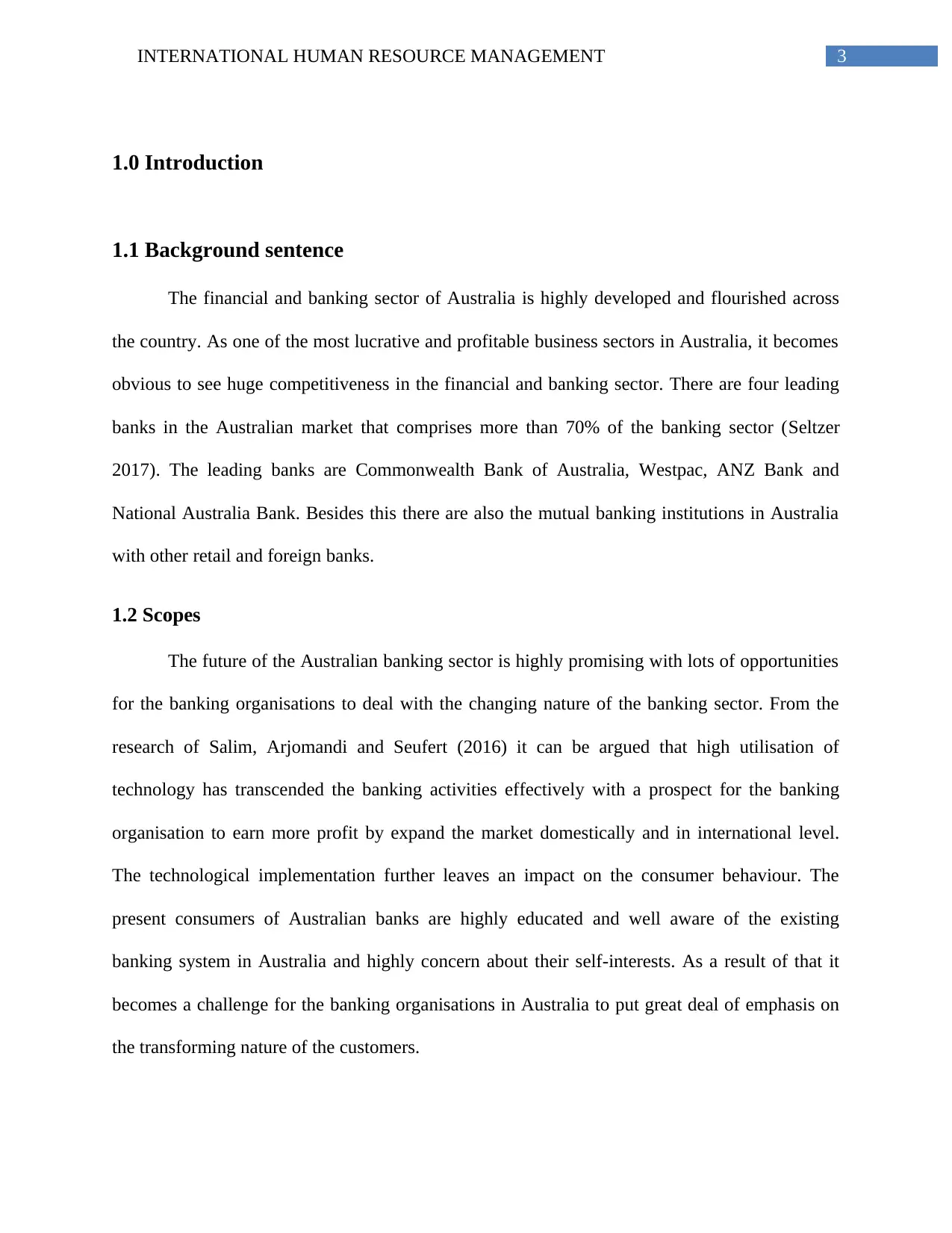
3INTERNATIONAL HUMAN RESOURCE MANAGEMENT
1.0 Introduction
1.1 Background sentence
The financial and banking sector of Australia is highly developed and flourished across
the country. As one of the most lucrative and profitable business sectors in Australia, it becomes
obvious to see huge competitiveness in the financial and banking sector. There are four leading
banks in the Australian market that comprises more than 70% of the banking sector (Seltzer
2017). The leading banks are Commonwealth Bank of Australia, Westpac, ANZ Bank and
National Australia Bank. Besides this there are also the mutual banking institutions in Australia
with other retail and foreign banks.
1.2 Scopes
The future of the Australian banking sector is highly promising with lots of opportunities
for the banking organisations to deal with the changing nature of the banking sector. From the
research of Salim, Arjomandi and Seufert (2016) it can be argued that high utilisation of
technology has transcended the banking activities effectively with a prospect for the banking
organisation to earn more profit by expand the market domestically and in international level.
The technological implementation further leaves an impact on the consumer behaviour. The
present consumers of Australian banks are highly educated and well aware of the existing
banking system in Australia and highly concern about their self-interests. As a result of that it
becomes a challenge for the banking organisations in Australia to put great deal of emphasis on
the transforming nature of the customers.
1.0 Introduction
1.1 Background sentence
The financial and banking sector of Australia is highly developed and flourished across
the country. As one of the most lucrative and profitable business sectors in Australia, it becomes
obvious to see huge competitiveness in the financial and banking sector. There are four leading
banks in the Australian market that comprises more than 70% of the banking sector (Seltzer
2017). The leading banks are Commonwealth Bank of Australia, Westpac, ANZ Bank and
National Australia Bank. Besides this there are also the mutual banking institutions in Australia
with other retail and foreign banks.
1.2 Scopes
The future of the Australian banking sector is highly promising with lots of opportunities
for the banking organisations to deal with the changing nature of the banking sector. From the
research of Salim, Arjomandi and Seufert (2016) it can be argued that high utilisation of
technology has transcended the banking activities effectively with a prospect for the banking
organisation to earn more profit by expand the market domestically and in international level.
The technological implementation further leaves an impact on the consumer behaviour. The
present consumers of Australian banks are highly educated and well aware of the existing
banking system in Australia and highly concern about their self-interests. As a result of that it
becomes a challenge for the banking organisations in Australia to put great deal of emphasis on
the transforming nature of the customers.
Paraphrase This Document
Need a fresh take? Get an instant paraphrase of this document with our AI Paraphraser
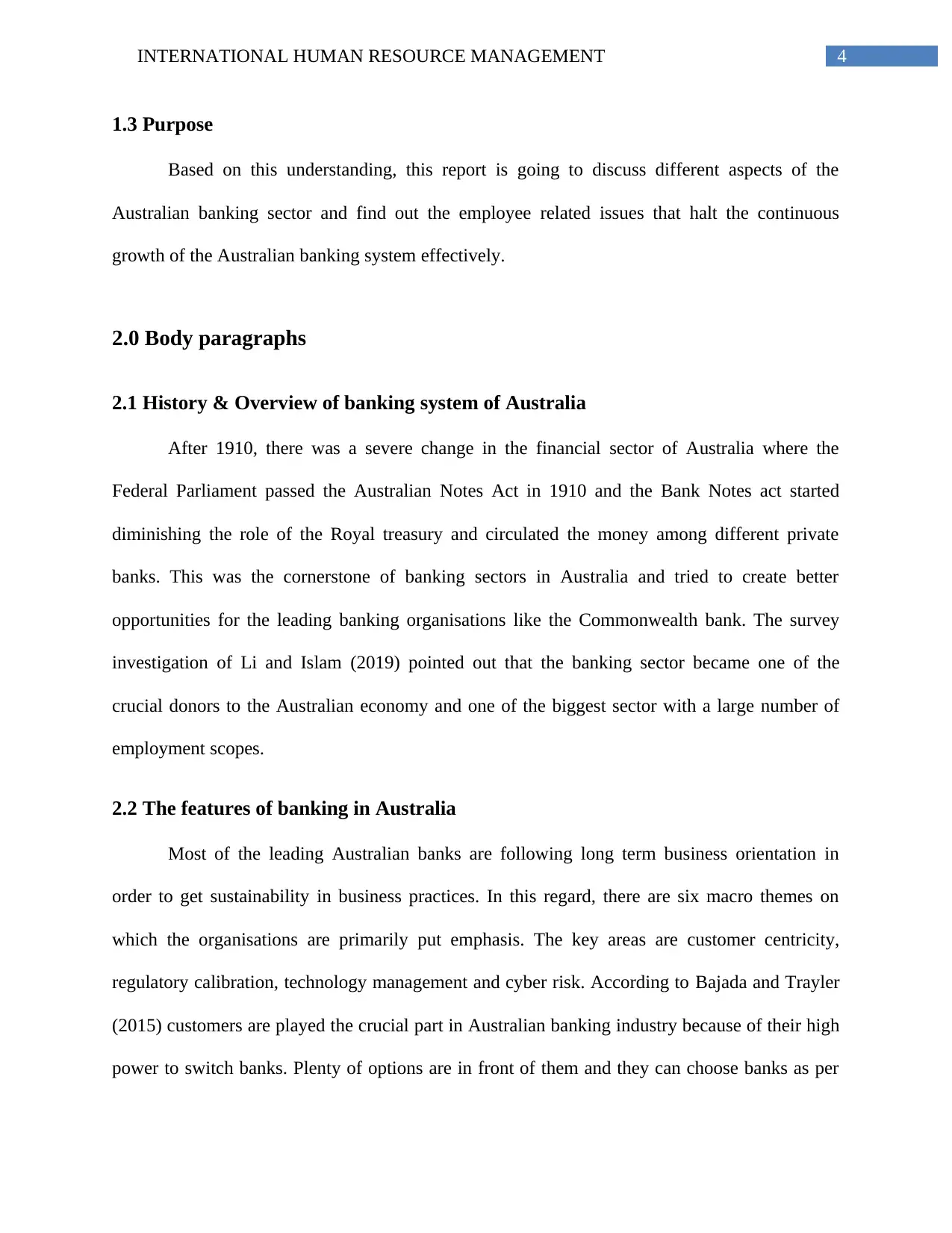
4INTERNATIONAL HUMAN RESOURCE MANAGEMENT
1.3 Purpose
Based on this understanding, this report is going to discuss different aspects of the
Australian banking sector and find out the employee related issues that halt the continuous
growth of the Australian banking system effectively.
2.0 Body paragraphs
2.1 History & Overview of banking system of Australia
After 1910, there was a severe change in the financial sector of Australia where the
Federal Parliament passed the Australian Notes Act in 1910 and the Bank Notes act started
diminishing the role of the Royal treasury and circulated the money among different private
banks. This was the cornerstone of banking sectors in Australia and tried to create better
opportunities for the leading banking organisations like the Commonwealth bank. The survey
investigation of Li and Islam (2019) pointed out that the banking sector became one of the
crucial donors to the Australian economy and one of the biggest sector with a large number of
employment scopes.
2.2 The features of banking in Australia
Most of the leading Australian banks are following long term business orientation in
order to get sustainability in business practices. In this regard, there are six macro themes on
which the organisations are primarily put emphasis. The key areas are customer centricity,
regulatory calibration, technology management and cyber risk. According to Bajada and Trayler
(2015) customers are played the crucial part in Australian banking industry because of their high
power to switch banks. Plenty of options are in front of them and they can choose banks as per
1.3 Purpose
Based on this understanding, this report is going to discuss different aspects of the
Australian banking sector and find out the employee related issues that halt the continuous
growth of the Australian banking system effectively.
2.0 Body paragraphs
2.1 History & Overview of banking system of Australia
After 1910, there was a severe change in the financial sector of Australia where the
Federal Parliament passed the Australian Notes Act in 1910 and the Bank Notes act started
diminishing the role of the Royal treasury and circulated the money among different private
banks. This was the cornerstone of banking sectors in Australia and tried to create better
opportunities for the leading banking organisations like the Commonwealth bank. The survey
investigation of Li and Islam (2019) pointed out that the banking sector became one of the
crucial donors to the Australian economy and one of the biggest sector with a large number of
employment scopes.
2.2 The features of banking in Australia
Most of the leading Australian banks are following long term business orientation in
order to get sustainability in business practices. In this regard, there are six macro themes on
which the organisations are primarily put emphasis. The key areas are customer centricity,
regulatory calibration, technology management and cyber risk. According to Bajada and Trayler
(2015) customers are played the crucial part in Australian banking industry because of their high
power to switch banks. Plenty of options are in front of them and they can choose banks as per
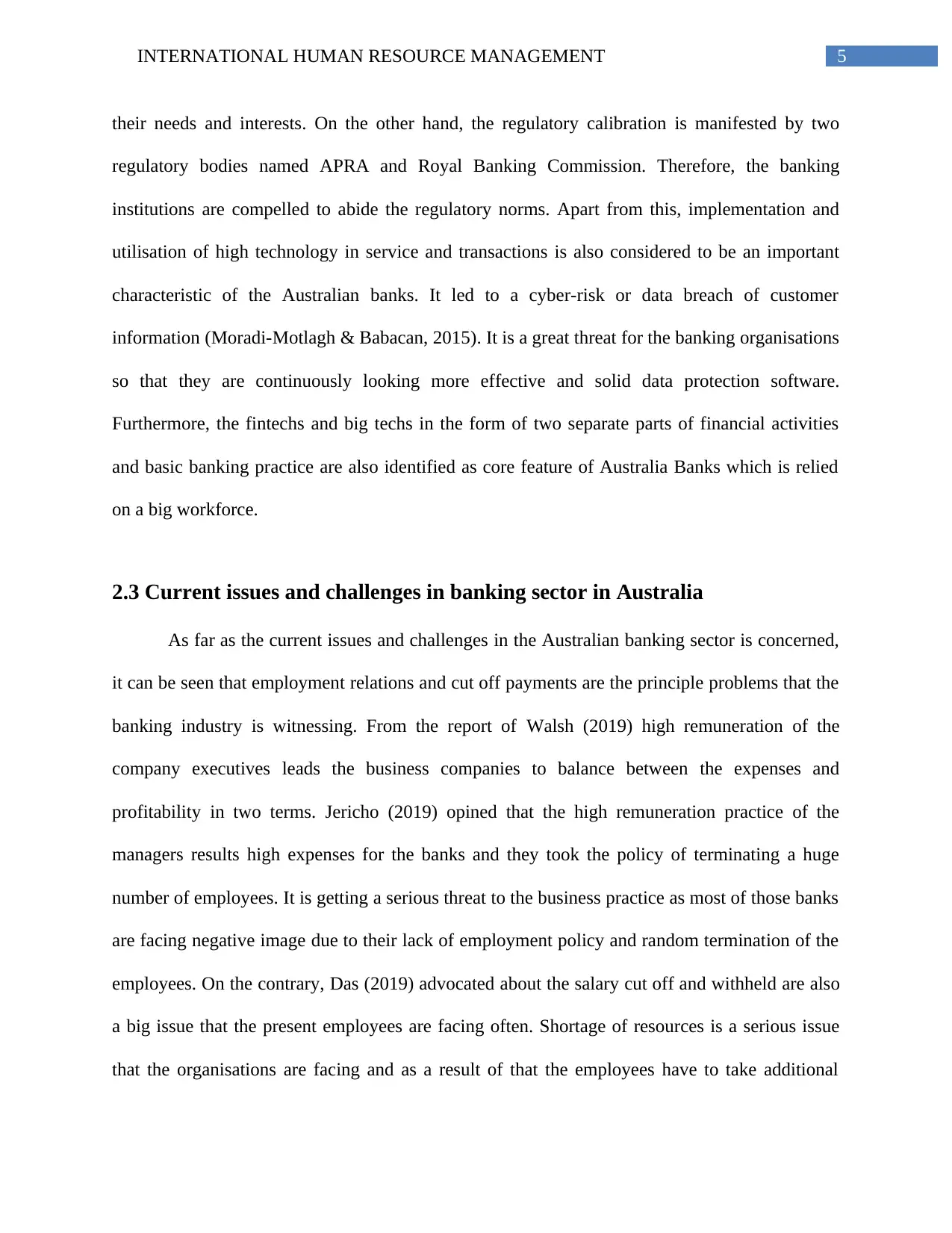
5INTERNATIONAL HUMAN RESOURCE MANAGEMENT
their needs and interests. On the other hand, the regulatory calibration is manifested by two
regulatory bodies named APRA and Royal Banking Commission. Therefore, the banking
institutions are compelled to abide the regulatory norms. Apart from this, implementation and
utilisation of high technology in service and transactions is also considered to be an important
characteristic of the Australian banks. It led to a cyber-risk or data breach of customer
information (Moradi-Motlagh & Babacan, 2015). It is a great threat for the banking organisations
so that they are continuously looking more effective and solid data protection software.
Furthermore, the fintechs and big techs in the form of two separate parts of financial activities
and basic banking practice are also identified as core feature of Australia Banks which is relied
on a big workforce.
2.3 Current issues and challenges in banking sector in Australia
As far as the current issues and challenges in the Australian banking sector is concerned,
it can be seen that employment relations and cut off payments are the principle problems that the
banking industry is witnessing. From the report of Walsh (2019) high remuneration of the
company executives leads the business companies to balance between the expenses and
profitability in two terms. Jericho (2019) opined that the high remuneration practice of the
managers results high expenses for the banks and they took the policy of terminating a huge
number of employees. It is getting a serious threat to the business practice as most of those banks
are facing negative image due to their lack of employment policy and random termination of the
employees. On the contrary, Das (2019) advocated about the salary cut off and withheld are also
a big issue that the present employees are facing often. Shortage of resources is a serious issue
that the organisations are facing and as a result of that the employees have to take additional
their needs and interests. On the other hand, the regulatory calibration is manifested by two
regulatory bodies named APRA and Royal Banking Commission. Therefore, the banking
institutions are compelled to abide the regulatory norms. Apart from this, implementation and
utilisation of high technology in service and transactions is also considered to be an important
characteristic of the Australian banks. It led to a cyber-risk or data breach of customer
information (Moradi-Motlagh & Babacan, 2015). It is a great threat for the banking organisations
so that they are continuously looking more effective and solid data protection software.
Furthermore, the fintechs and big techs in the form of two separate parts of financial activities
and basic banking practice are also identified as core feature of Australia Banks which is relied
on a big workforce.
2.3 Current issues and challenges in banking sector in Australia
As far as the current issues and challenges in the Australian banking sector is concerned,
it can be seen that employment relations and cut off payments are the principle problems that the
banking industry is witnessing. From the report of Walsh (2019) high remuneration of the
company executives leads the business companies to balance between the expenses and
profitability in two terms. Jericho (2019) opined that the high remuneration practice of the
managers results high expenses for the banks and they took the policy of terminating a huge
number of employees. It is getting a serious threat to the business practice as most of those banks
are facing negative image due to their lack of employment policy and random termination of the
employees. On the contrary, Das (2019) advocated about the salary cut off and withheld are also
a big issue that the present employees are facing often. Shortage of resources is a serious issue
that the organisations are facing and as a result of that the employees have to take additional
⊘ This is a preview!⊘
Do you want full access?
Subscribe today to unlock all pages.

Trusted by 1+ million students worldwide
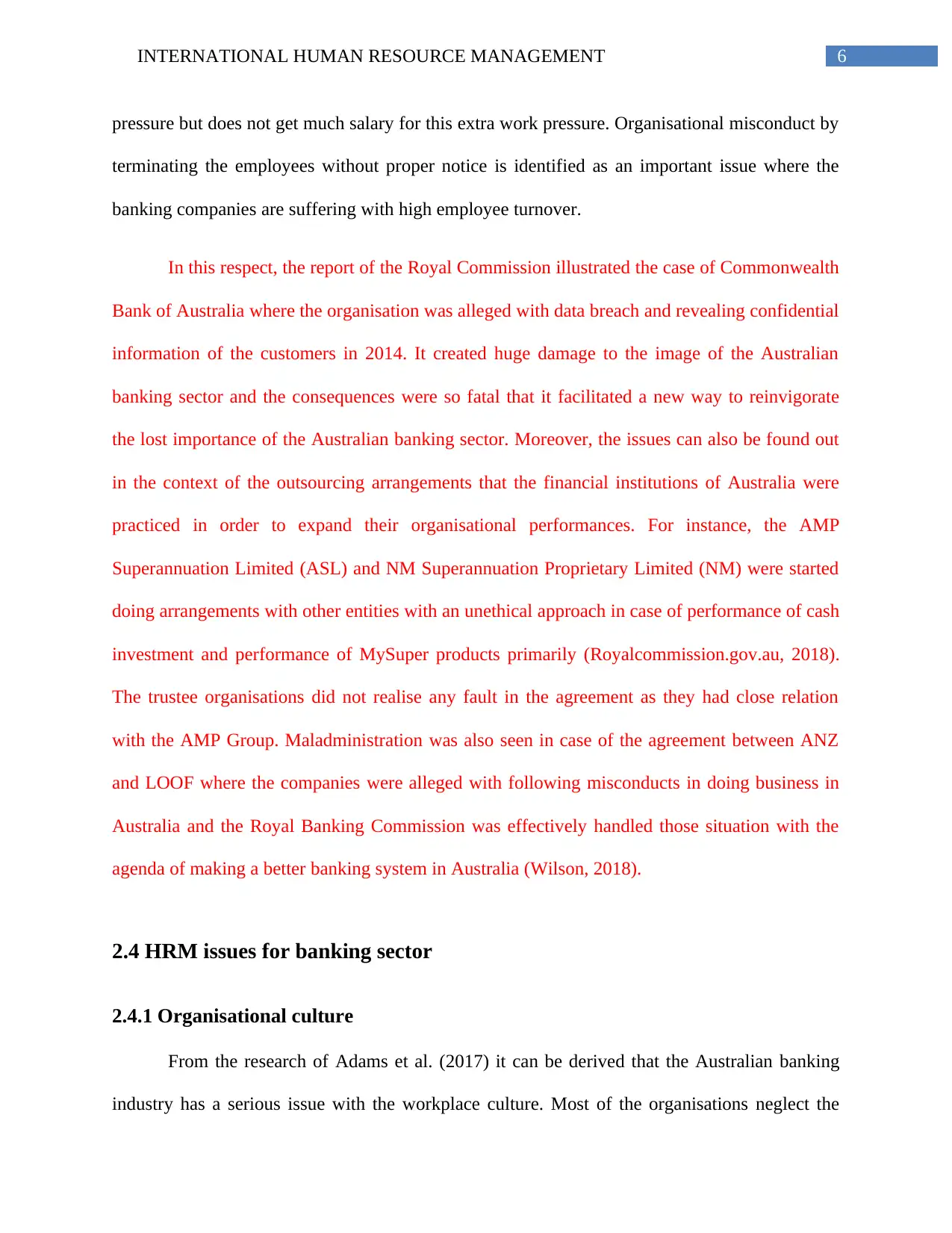
6INTERNATIONAL HUMAN RESOURCE MANAGEMENT
pressure but does not get much salary for this extra work pressure. Organisational misconduct by
terminating the employees without proper notice is identified as an important issue where the
banking companies are suffering with high employee turnover.
In this respect, the report of the Royal Commission illustrated the case of Commonwealth
Bank of Australia where the organisation was alleged with data breach and revealing confidential
information of the customers in 2014. It created huge damage to the image of the Australian
banking sector and the consequences were so fatal that it facilitated a new way to reinvigorate
the lost importance of the Australian banking sector. Moreover, the issues can also be found out
in the context of the outsourcing arrangements that the financial institutions of Australia were
practiced in order to expand their organisational performances. For instance, the AMP
Superannuation Limited (ASL) and NM Superannuation Proprietary Limited (NM) were started
doing arrangements with other entities with an unethical approach in case of performance of cash
investment and performance of MySuper products primarily (Royalcommission.gov.au, 2018).
The trustee organisations did not realise any fault in the agreement as they had close relation
with the AMP Group. Maladministration was also seen in case of the agreement between ANZ
and LOOF where the companies were alleged with following misconducts in doing business in
Australia and the Royal Banking Commission was effectively handled those situation with the
agenda of making a better banking system in Australia (Wilson, 2018).
2.4 HRM issues for banking sector
2.4.1 Organisational culture
From the research of Adams et al. (2017) it can be derived that the Australian banking
industry has a serious issue with the workplace culture. Most of the organisations neglect the
pressure but does not get much salary for this extra work pressure. Organisational misconduct by
terminating the employees without proper notice is identified as an important issue where the
banking companies are suffering with high employee turnover.
In this respect, the report of the Royal Commission illustrated the case of Commonwealth
Bank of Australia where the organisation was alleged with data breach and revealing confidential
information of the customers in 2014. It created huge damage to the image of the Australian
banking sector and the consequences were so fatal that it facilitated a new way to reinvigorate
the lost importance of the Australian banking sector. Moreover, the issues can also be found out
in the context of the outsourcing arrangements that the financial institutions of Australia were
practiced in order to expand their organisational performances. For instance, the AMP
Superannuation Limited (ASL) and NM Superannuation Proprietary Limited (NM) were started
doing arrangements with other entities with an unethical approach in case of performance of cash
investment and performance of MySuper products primarily (Royalcommission.gov.au, 2018).
The trustee organisations did not realise any fault in the agreement as they had close relation
with the AMP Group. Maladministration was also seen in case of the agreement between ANZ
and LOOF where the companies were alleged with following misconducts in doing business in
Australia and the Royal Banking Commission was effectively handled those situation with the
agenda of making a better banking system in Australia (Wilson, 2018).
2.4 HRM issues for banking sector
2.4.1 Organisational culture
From the research of Adams et al. (2017) it can be derived that the Australian banking
industry has a serious issue with the workplace culture. Most of the organisations neglect the
Paraphrase This Document
Need a fresh take? Get an instant paraphrase of this document with our AI Paraphraser
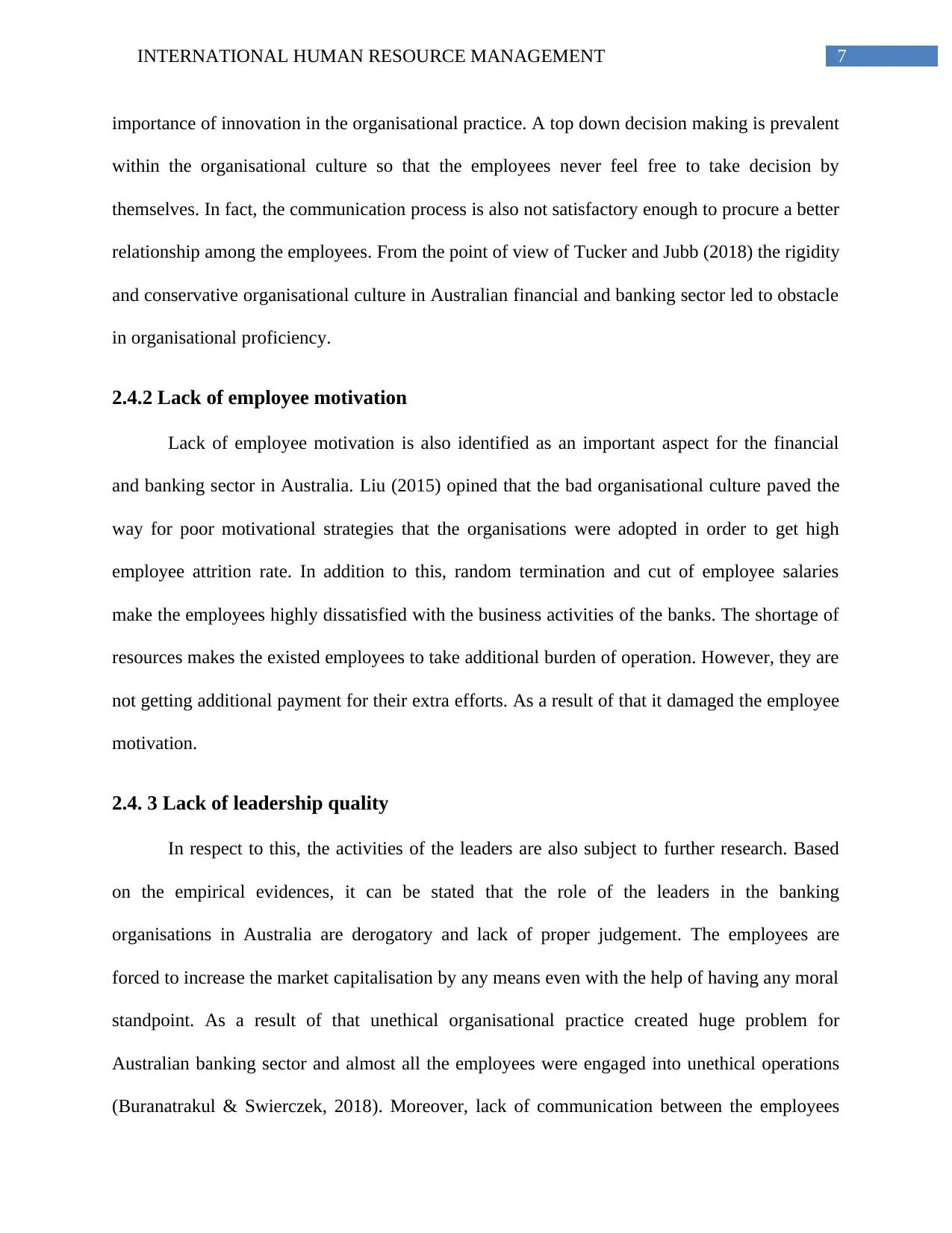
7INTERNATIONAL HUMAN RESOURCE MANAGEMENT
importance of innovation in the organisational practice. A top down decision making is prevalent
within the organisational culture so that the employees never feel free to take decision by
themselves. In fact, the communication process is also not satisfactory enough to procure a better
relationship among the employees. From the point of view of Tucker and Jubb (2018) the rigidity
and conservative organisational culture in Australian financial and banking sector led to obstacle
in organisational proficiency.
2.4.2 Lack of employee motivation
Lack of employee motivation is also identified as an important aspect for the financial
and banking sector in Australia. Liu (2015) opined that the bad organisational culture paved the
way for poor motivational strategies that the organisations were adopted in order to get high
employee attrition rate. In addition to this, random termination and cut of employee salaries
make the employees highly dissatisfied with the business activities of the banks. The shortage of
resources makes the existed employees to take additional burden of operation. However, they are
not getting additional payment for their extra efforts. As a result of that it damaged the employee
motivation.
2.4. 3 Lack of leadership quality
In respect to this, the activities of the leaders are also subject to further research. Based
on the empirical evidences, it can be stated that the role of the leaders in the banking
organisations in Australia are derogatory and lack of proper judgement. The employees are
forced to increase the market capitalisation by any means even with the help of having any moral
standpoint. As a result of that unethical organisational practice created huge problem for
Australian banking sector and almost all the employees were engaged into unethical operations
(Buranatrakul & Swierczek, 2018). Moreover, lack of communication between the employees
importance of innovation in the organisational practice. A top down decision making is prevalent
within the organisational culture so that the employees never feel free to take decision by
themselves. In fact, the communication process is also not satisfactory enough to procure a better
relationship among the employees. From the point of view of Tucker and Jubb (2018) the rigidity
and conservative organisational culture in Australian financial and banking sector led to obstacle
in organisational proficiency.
2.4.2 Lack of employee motivation
Lack of employee motivation is also identified as an important aspect for the financial
and banking sector in Australia. Liu (2015) opined that the bad organisational culture paved the
way for poor motivational strategies that the organisations were adopted in order to get high
employee attrition rate. In addition to this, random termination and cut of employee salaries
make the employees highly dissatisfied with the business activities of the banks. The shortage of
resources makes the existed employees to take additional burden of operation. However, they are
not getting additional payment for their extra efforts. As a result of that it damaged the employee
motivation.
2.4. 3 Lack of leadership quality
In respect to this, the activities of the leaders are also subject to further research. Based
on the empirical evidences, it can be stated that the role of the leaders in the banking
organisations in Australia are derogatory and lack of proper judgement. The employees are
forced to increase the market capitalisation by any means even with the help of having any moral
standpoint. As a result of that unethical organisational practice created huge problem for
Australian banking sector and almost all the employees were engaged into unethical operations
(Buranatrakul & Swierczek, 2018). Moreover, lack of communication between the employees
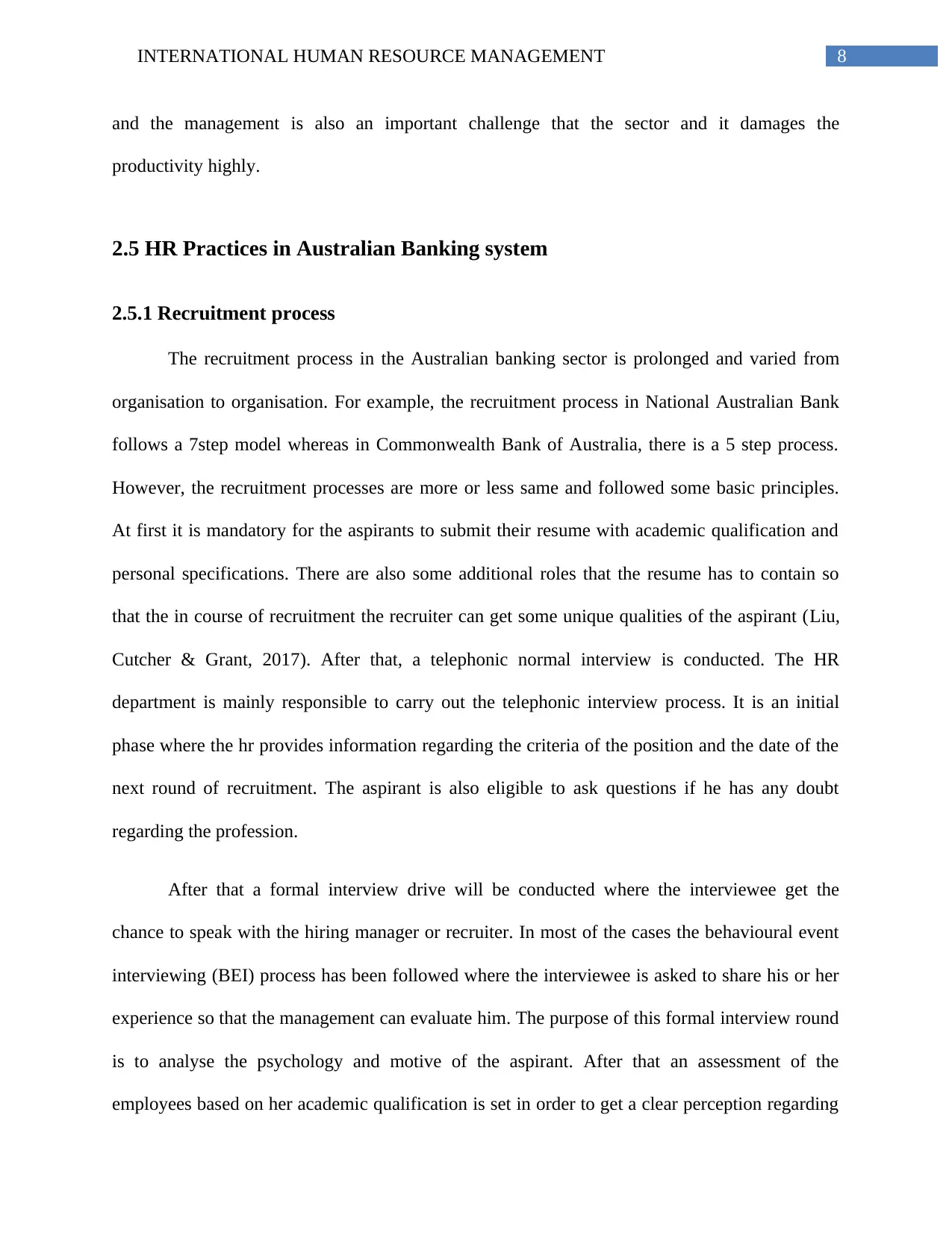
8INTERNATIONAL HUMAN RESOURCE MANAGEMENT
and the management is also an important challenge that the sector and it damages the
productivity highly.
2.5 HR Practices in Australian Banking system
2.5.1 Recruitment process
The recruitment process in the Australian banking sector is prolonged and varied from
organisation to organisation. For example, the recruitment process in National Australian Bank
follows a 7step model whereas in Commonwealth Bank of Australia, there is a 5 step process.
However, the recruitment processes are more or less same and followed some basic principles.
At first it is mandatory for the aspirants to submit their resume with academic qualification and
personal specifications. There are also some additional roles that the resume has to contain so
that the in course of recruitment the recruiter can get some unique qualities of the aspirant (Liu,
Cutcher & Grant, 2017). After that, a telephonic normal interview is conducted. The HR
department is mainly responsible to carry out the telephonic interview process. It is an initial
phase where the hr provides information regarding the criteria of the position and the date of the
next round of recruitment. The aspirant is also eligible to ask questions if he has any doubt
regarding the profession.
After that a formal interview drive will be conducted where the interviewee get the
chance to speak with the hiring manager or recruiter. In most of the cases the behavioural event
interviewing (BEI) process has been followed where the interviewee is asked to share his or her
experience so that the management can evaluate him. The purpose of this formal interview round
is to analyse the psychology and motive of the aspirant. After that an assessment of the
employees based on her academic qualification is set in order to get a clear perception regarding
and the management is also an important challenge that the sector and it damages the
productivity highly.
2.5 HR Practices in Australian Banking system
2.5.1 Recruitment process
The recruitment process in the Australian banking sector is prolonged and varied from
organisation to organisation. For example, the recruitment process in National Australian Bank
follows a 7step model whereas in Commonwealth Bank of Australia, there is a 5 step process.
However, the recruitment processes are more or less same and followed some basic principles.
At first it is mandatory for the aspirants to submit their resume with academic qualification and
personal specifications. There are also some additional roles that the resume has to contain so
that the in course of recruitment the recruiter can get some unique qualities of the aspirant (Liu,
Cutcher & Grant, 2017). After that, a telephonic normal interview is conducted. The HR
department is mainly responsible to carry out the telephonic interview process. It is an initial
phase where the hr provides information regarding the criteria of the position and the date of the
next round of recruitment. The aspirant is also eligible to ask questions if he has any doubt
regarding the profession.
After that a formal interview drive will be conducted where the interviewee get the
chance to speak with the hiring manager or recruiter. In most of the cases the behavioural event
interviewing (BEI) process has been followed where the interviewee is asked to share his or her
experience so that the management can evaluate him. The purpose of this formal interview round
is to analyse the psychology and motive of the aspirant. After that an assessment of the
employees based on her academic qualification is set in order to get a clear perception regarding
⊘ This is a preview!⊘
Do you want full access?
Subscribe today to unlock all pages.

Trusted by 1+ million students worldwide
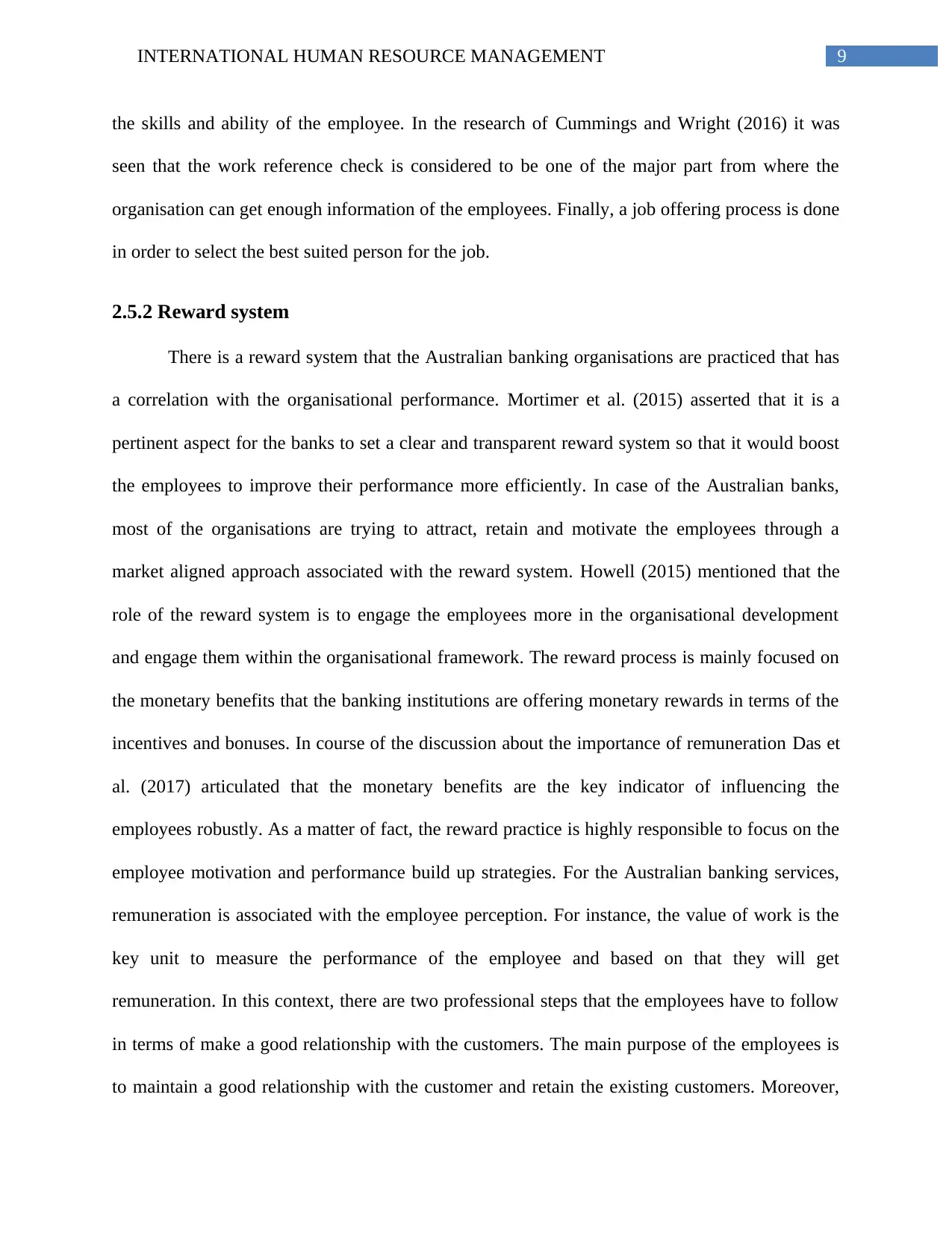
9INTERNATIONAL HUMAN RESOURCE MANAGEMENT
the skills and ability of the employee. In the research of Cummings and Wright (2016) it was
seen that the work reference check is considered to be one of the major part from where the
organisation can get enough information of the employees. Finally, a job offering process is done
in order to select the best suited person for the job.
2.5.2 Reward system
There is a reward system that the Australian banking organisations are practiced that has
a correlation with the organisational performance. Mortimer et al. (2015) asserted that it is a
pertinent aspect for the banks to set a clear and transparent reward system so that it would boost
the employees to improve their performance more efficiently. In case of the Australian banks,
most of the organisations are trying to attract, retain and motivate the employees through a
market aligned approach associated with the reward system. Howell (2015) mentioned that the
role of the reward system is to engage the employees more in the organisational development
and engage them within the organisational framework. The reward process is mainly focused on
the monetary benefits that the banking institutions are offering monetary rewards in terms of the
incentives and bonuses. In course of the discussion about the importance of remuneration Das et
al. (2017) articulated that the monetary benefits are the key indicator of influencing the
employees robustly. As a matter of fact, the reward practice is highly responsible to focus on the
employee motivation and performance build up strategies. For the Australian banking services,
remuneration is associated with the employee perception. For instance, the value of work is the
key unit to measure the performance of the employee and based on that they will get
remuneration. In this context, there are two professional steps that the employees have to follow
in terms of make a good relationship with the customers. The main purpose of the employees is
to maintain a good relationship with the customer and retain the existing customers. Moreover,
the skills and ability of the employee. In the research of Cummings and Wright (2016) it was
seen that the work reference check is considered to be one of the major part from where the
organisation can get enough information of the employees. Finally, a job offering process is done
in order to select the best suited person for the job.
2.5.2 Reward system
There is a reward system that the Australian banking organisations are practiced that has
a correlation with the organisational performance. Mortimer et al. (2015) asserted that it is a
pertinent aspect for the banks to set a clear and transparent reward system so that it would boost
the employees to improve their performance more efficiently. In case of the Australian banks,
most of the organisations are trying to attract, retain and motivate the employees through a
market aligned approach associated with the reward system. Howell (2015) mentioned that the
role of the reward system is to engage the employees more in the organisational development
and engage them within the organisational framework. The reward process is mainly focused on
the monetary benefits that the banking institutions are offering monetary rewards in terms of the
incentives and bonuses. In course of the discussion about the importance of remuneration Das et
al. (2017) articulated that the monetary benefits are the key indicator of influencing the
employees robustly. As a matter of fact, the reward practice is highly responsible to focus on the
employee motivation and performance build up strategies. For the Australian banking services,
remuneration is associated with the employee perception. For instance, the value of work is the
key unit to measure the performance of the employee and based on that they will get
remuneration. In this context, there are two professional steps that the employees have to follow
in terms of make a good relationship with the customers. The main purpose of the employees is
to maintain a good relationship with the customer and retain the existing customers. Moreover,
Paraphrase This Document
Need a fresh take? Get an instant paraphrase of this document with our AI Paraphraser
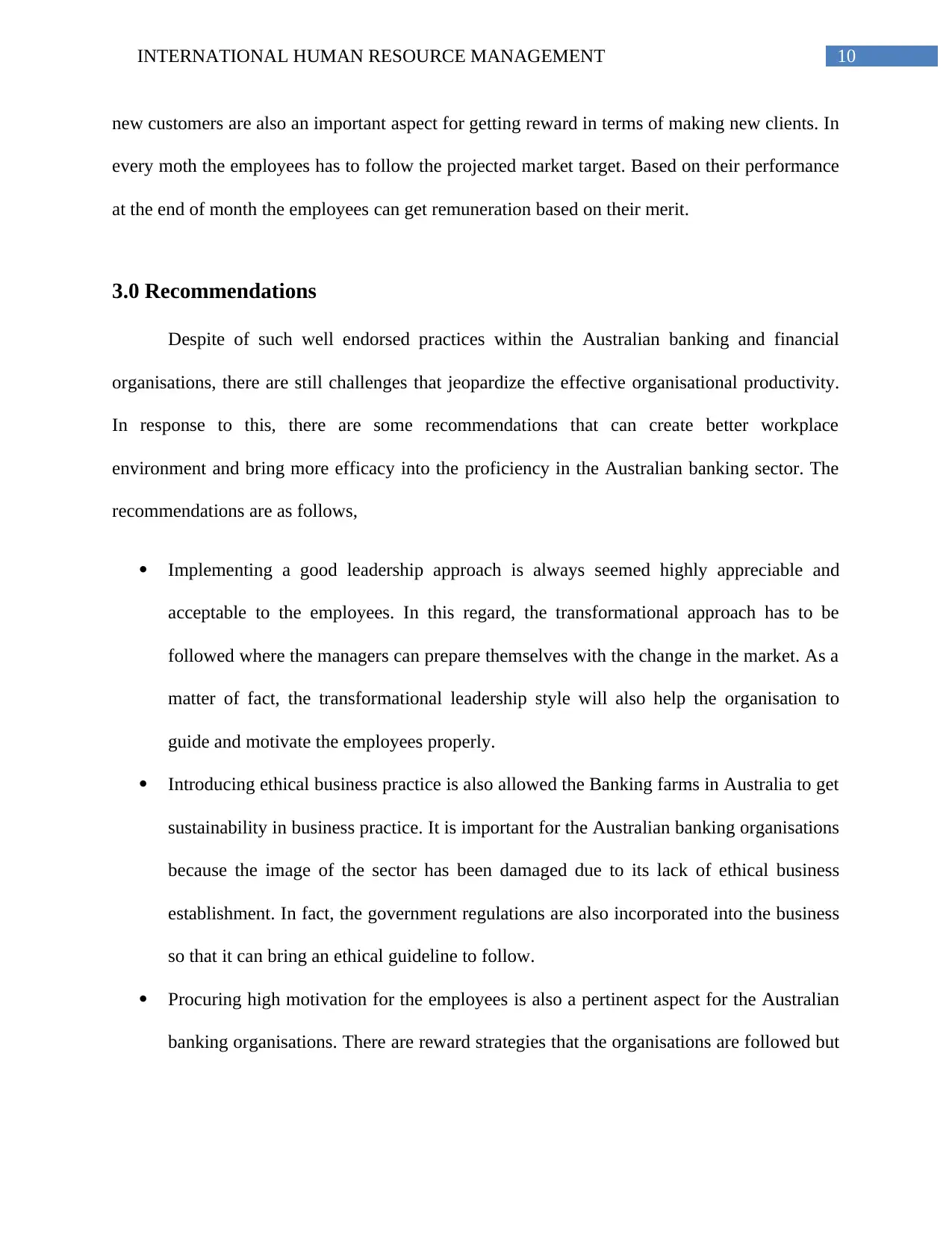
10INTERNATIONAL HUMAN RESOURCE MANAGEMENT
new customers are also an important aspect for getting reward in terms of making new clients. In
every moth the employees has to follow the projected market target. Based on their performance
at the end of month the employees can get remuneration based on their merit.
3.0 Recommendations
Despite of such well endorsed practices within the Australian banking and financial
organisations, there are still challenges that jeopardize the effective organisational productivity.
In response to this, there are some recommendations that can create better workplace
environment and bring more efficacy into the proficiency in the Australian banking sector. The
recommendations are as follows,
Implementing a good leadership approach is always seemed highly appreciable and
acceptable to the employees. In this regard, the transformational approach has to be
followed where the managers can prepare themselves with the change in the market. As a
matter of fact, the transformational leadership style will also help the organisation to
guide and motivate the employees properly.
Introducing ethical business practice is also allowed the Banking farms in Australia to get
sustainability in business practice. It is important for the Australian banking organisations
because the image of the sector has been damaged due to its lack of ethical business
establishment. In fact, the government regulations are also incorporated into the business
so that it can bring an ethical guideline to follow.
Procuring high motivation for the employees is also a pertinent aspect for the Australian
banking organisations. There are reward strategies that the organisations are followed but
new customers are also an important aspect for getting reward in terms of making new clients. In
every moth the employees has to follow the projected market target. Based on their performance
at the end of month the employees can get remuneration based on their merit.
3.0 Recommendations
Despite of such well endorsed practices within the Australian banking and financial
organisations, there are still challenges that jeopardize the effective organisational productivity.
In response to this, there are some recommendations that can create better workplace
environment and bring more efficacy into the proficiency in the Australian banking sector. The
recommendations are as follows,
Implementing a good leadership approach is always seemed highly appreciable and
acceptable to the employees. In this regard, the transformational approach has to be
followed where the managers can prepare themselves with the change in the market. As a
matter of fact, the transformational leadership style will also help the organisation to
guide and motivate the employees properly.
Introducing ethical business practice is also allowed the Banking farms in Australia to get
sustainability in business practice. It is important for the Australian banking organisations
because the image of the sector has been damaged due to its lack of ethical business
establishment. In fact, the government regulations are also incorporated into the business
so that it can bring an ethical guideline to follow.
Procuring high motivation for the employees is also a pertinent aspect for the Australian
banking organisations. There are reward strategies that the organisations are followed but
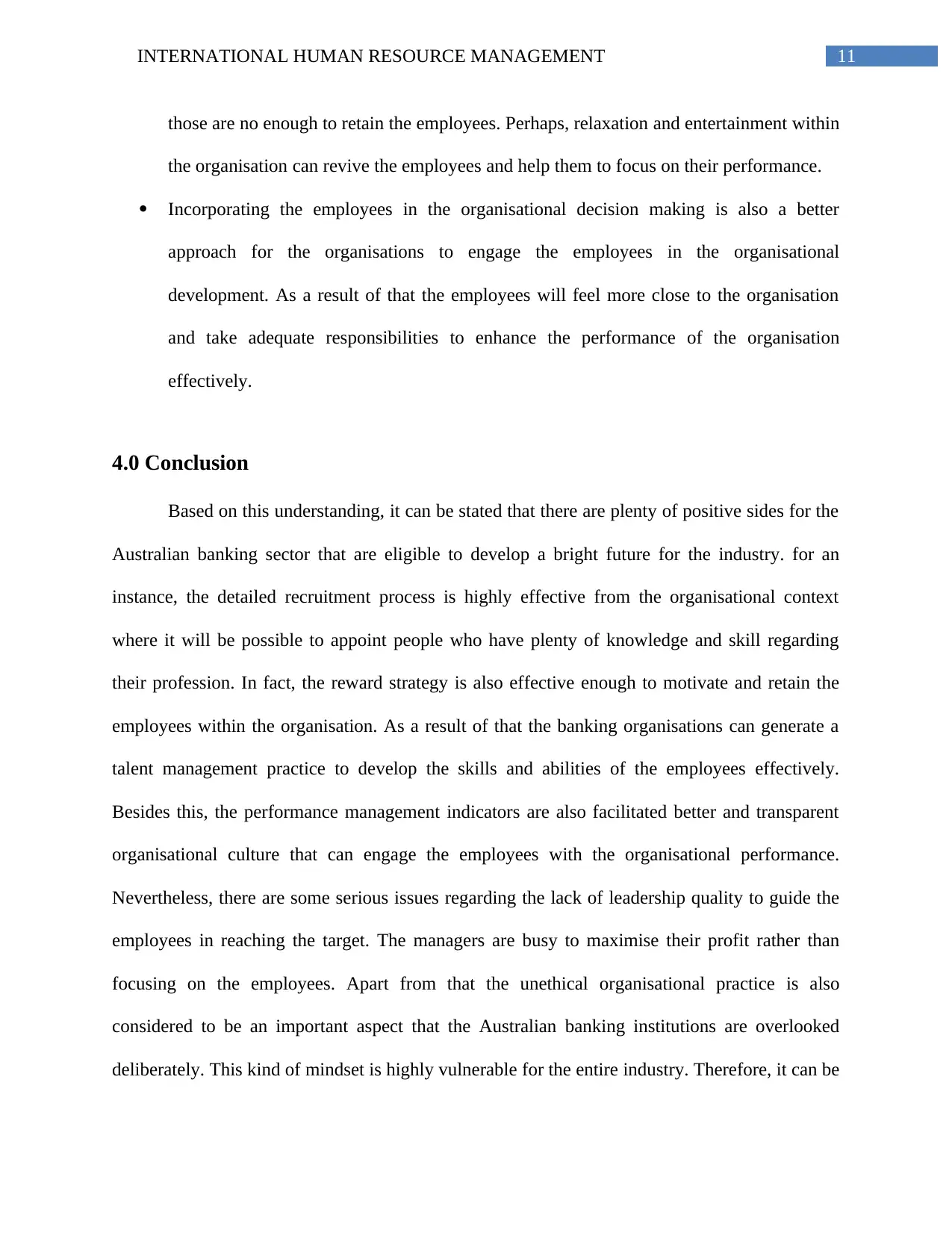
11INTERNATIONAL HUMAN RESOURCE MANAGEMENT
those are no enough to retain the employees. Perhaps, relaxation and entertainment within
the organisation can revive the employees and help them to focus on their performance.
Incorporating the employees in the organisational decision making is also a better
approach for the organisations to engage the employees in the organisational
development. As a result of that the employees will feel more close to the organisation
and take adequate responsibilities to enhance the performance of the organisation
effectively.
4.0 Conclusion
Based on this understanding, it can be stated that there are plenty of positive sides for the
Australian banking sector that are eligible to develop a bright future for the industry. for an
instance, the detailed recruitment process is highly effective from the organisational context
where it will be possible to appoint people who have plenty of knowledge and skill regarding
their profession. In fact, the reward strategy is also effective enough to motivate and retain the
employees within the organisation. As a result of that the banking organisations can generate a
talent management practice to develop the skills and abilities of the employees effectively.
Besides this, the performance management indicators are also facilitated better and transparent
organisational culture that can engage the employees with the organisational performance.
Nevertheless, there are some serious issues regarding the lack of leadership quality to guide the
employees in reaching the target. The managers are busy to maximise their profit rather than
focusing on the employees. Apart from that the unethical organisational practice is also
considered to be an important aspect that the Australian banking institutions are overlooked
deliberately. This kind of mindset is highly vulnerable for the entire industry. Therefore, it can be
those are no enough to retain the employees. Perhaps, relaxation and entertainment within
the organisation can revive the employees and help them to focus on their performance.
Incorporating the employees in the organisational decision making is also a better
approach for the organisations to engage the employees in the organisational
development. As a result of that the employees will feel more close to the organisation
and take adequate responsibilities to enhance the performance of the organisation
effectively.
4.0 Conclusion
Based on this understanding, it can be stated that there are plenty of positive sides for the
Australian banking sector that are eligible to develop a bright future for the industry. for an
instance, the detailed recruitment process is highly effective from the organisational context
where it will be possible to appoint people who have plenty of knowledge and skill regarding
their profession. In fact, the reward strategy is also effective enough to motivate and retain the
employees within the organisation. As a result of that the banking organisations can generate a
talent management practice to develop the skills and abilities of the employees effectively.
Besides this, the performance management indicators are also facilitated better and transparent
organisational culture that can engage the employees with the organisational performance.
Nevertheless, there are some serious issues regarding the lack of leadership quality to guide the
employees in reaching the target. The managers are busy to maximise their profit rather than
focusing on the employees. Apart from that the unethical organisational practice is also
considered to be an important aspect that the Australian banking institutions are overlooked
deliberately. This kind of mindset is highly vulnerable for the entire industry. Therefore, it can be
⊘ This is a preview!⊘
Do you want full access?
Subscribe today to unlock all pages.

Trusted by 1+ million students worldwide
1 out of 16
Related Documents
Your All-in-One AI-Powered Toolkit for Academic Success.
+13062052269
info@desklib.com
Available 24*7 on WhatsApp / Email
![[object Object]](/_next/static/media/star-bottom.7253800d.svg)
Unlock your academic potential
Copyright © 2020–2025 A2Z Services. All Rights Reserved. Developed and managed by ZUCOL.





